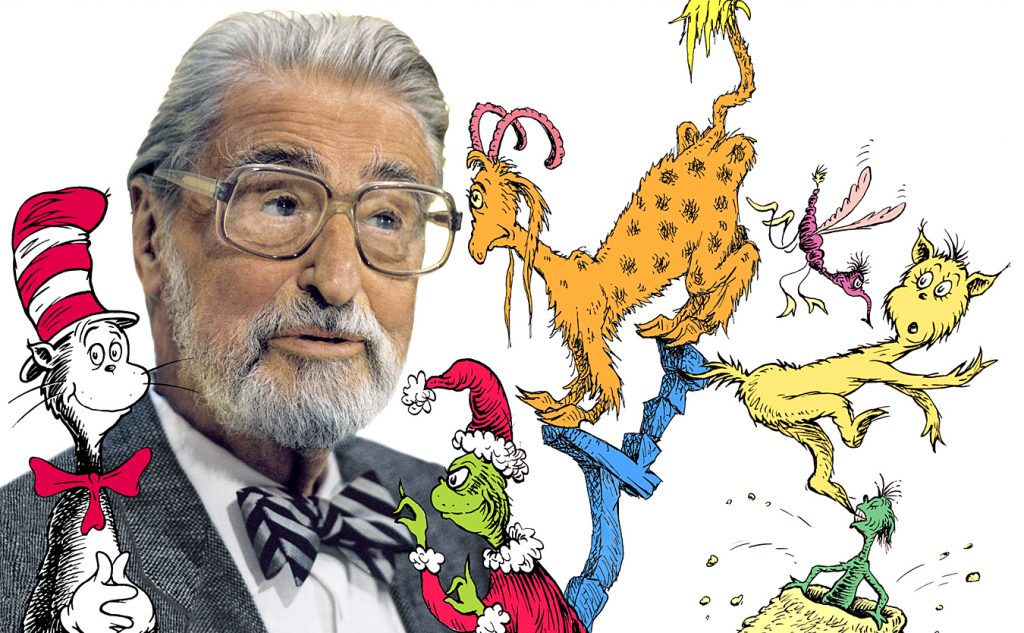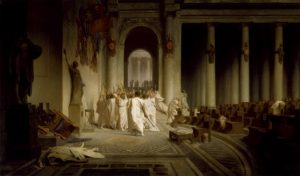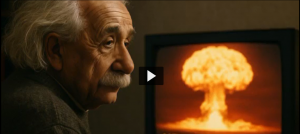Theodor Geisel, beloved children’s author, had a life before he put the hat on the cat. Born March 2, 1904, in Springfield, Massachusetts, Geisel was the only son of German-born immigrants. He spent a normal childhood with his sister and parents, before going to college to become a teacher. Geisel dropped out of college shortly before completing his doctorate in literature. He would eventually turn his almost doctorate and his mother’s maiden name into his now famous pen name, Dr. Seuss.1

In 1927, Geisel decided to turn his passion for drawing and writing into a career in advertising. One of his early successes in advertising was his drawing for Flit insecticide, whose mascot looked very similar to the cat that would eventually wear a striped hat.2 He later created an entire campaign for Essomarine Oil, a division of Standard Oil, called Seuss Navy, in which he designed certificates of membership, pamphlets, and even ashtrays and cocktail glasses that were passed out at trade shows. The Seuss Navy ads ran from 1936 to 1941, and contained many of the sea creatures that would later appear in his books.3 Geisel used many of his made up creatures in various ad campaigns and was the first person to use humor to sell products, altering the advertising industry.4

In 1941, Geisel left advertising to work as a political cartoonist for liberal New York newspaper PM. He drew over 4oo cartoons targeting such topics as isolationism, antisemitism, and racism. He routinely mocked Hitler and Mussolini, but he had a particular flair for attacking American nationalism as well. Believing that the American Nationalist Movement was just another form of fascism, Geisel made Charles Lindbergh a frequent subject of his cartoons.5 After the Japanese attack on Pearl Harbor, Geisel began to use his cartoons to support the war against Japan. He drew cartoons that “depicted Hideki Tojo, the Prime Minister and Supreme Military Leader of Japan, as an ugly stereotype, with squinting eyes and a sneering grin.”6 Geisel was in support of Japanese internment camps and drew several cartoons about them.

It can be hard to imagine that Dr. Seuss could be a racist in his depiction of Asians, but he later admitted that this was exactly the case. At the time, PM did not receive one letter of complaint about Geisel’s stereotypical depiction of Asians, although they received many letters when Geisel mocked the German dachshund, which was popular among American dog owners. Dr. Seuss later said that his 1954 book, “Horton Hears a Who,” written after a trip to Japan and dedicated to a Japanese friend, is meant to be an apology to the Japanese people for his depictions of them during World War II. In the 1980’s, Geisel looked through all his children’s books and removed anything he felt was racist, changing them for any future publication.7
Geisel’s political cartoons ended when he joined the Army in 1943. The now Captain Geisel was assigned to a unit that made training films for the Army, working with the likes of Stan Lee (creator of super heroes) and Chuck Jones (creator of the Road Runner and Wile E. Coyote).8 Geisel and Jones would become life long friends and would work together on various projects, including the animated “How the Grinch Stole Christmas,” which is still shown every year on television.

Geisel’s first children’s book was “And to Think I Saw It on Mulberry Street,” and was published in 1937. However, his writing career almost never happened. The book had been turned down by 27 publishers and Geisel was ready to give up the idea of becoming a children’s author when he ran into an old college friend while walking down the street. His friend had recently become an editor at Vanguard Press and asked Geisel to send him the book so he could show his boss. Geisel would later say in interviews that it was pure luck that he walked down that side of the street that day.9
Dr. Seuss later claimed that he did not like to write books that had a moral or ethical lesson, because children could see a lesson coming and would not want to read the book.10 However, all of Geisel’s books, except his Beginner Books, contained lessons of some sort. Dr. Seuss wrote books with lessons on environmentalism, racial equality, the pointlessness of the arms race, materialism, and respect, just to name a few. He was one of the first children’s authors to write books for children with the respect and care typically reserved for adult literature.11
Dr. Seuss died on September 24, 1991 at his home. He was asked shortly before he passed away to leave a message for children. He wrote “The best slogan I can think of to leave the kids of the U.S.A. would be ‘We can…and we’ve got to…do better than this.’ He then crossed out ‘the kids of.'”12 Dr. Seuss left a legacy of children’s literature that will not soon be forgotten, but he did more than that; Dr. Seuss taught children to think.
- Janet Schulman and Cathy Goldsmith, Your Favorite Seuss (New York: Random House, 2004), 6. ↵
- Louis Menand, “Cat People,” The New Yorker (December 2002). ↵
- Janet Schulman and Cathy Goldsmith, Your Favorite Seuss (New York: Random House, 2004), 55. ↵
- Janet Schulman and Cathy Goldsmith, Your Favorite Seuss (New York: Random House, 2004), 117. ↵
- Sophie Gilbert, “The Complicated Relevance of Dr. Seuss’s Political Cartoons,” The Atlantic (January 2017). ↵
- Sophie Gilbert, “The Complicated Relevance of Dr. Seuss’s Political Cartoons,” The Atlantic (January 2017). ↵
- Sophie Gilbert, “The Complicated Relevance of Dr. Seuss’s Political Cartoons,” The Atlantic (January 2017). ↵
- Janet Schulman and Cathy Goldsmith, Your Favorite Seuss (New York: Random House, 2004), 9. ↵
- Louis Menand, “Cat People,” The New Yorker (December 2002). ↵
- Janet Schulman and Cathy Goldsmith, Your Favorite Seuss (New York: Random House, 2004), 190. ↵
- Janet Schulman and Cathy Goldsmith, Your Favorite Seuss (New York: Random House, 2004), 84. ↵
- Janet Schulman and Cathy Goldsmith, Your Favorite Seuss (New York: Random House, 2004), 190. ↵



125 comments
Joel Gracia
This was an amazing article to read. I had no clue that my favorite children’s book author was so heavily involved in political activism before he began writing seemingly innocent stories for the youth. Knowing this, however, you can look into his well known books and find the same underlying themes that can be applied to much more serious issues in the world. He was truly an amazing author and genuine person.
Miranda Yzaguirre
I had no idea the depth of the person behind writing everyone’s favorite children’s novels. It is truly inspiring how he started out making political cartoons in newspapers and ads for companies. It is also inspiring that he had the guts to call out his own racism and do everything he could to undo it. I would have never thought “Horton Hears a Who” was an apology to the Japanese. It is also interesting that so many great writers and filmmakers were all in the military at once; and even became friends! This article was a fantastic and fun read.
Anthony Robledo
I loved the pictures in this article! They were used well and extremely lively, but I wished you would have had a better intro paragraph. The article overall was great, but the intro failed to catch my attention. you jump into your point a bit to fast. I was amazed to find out about Dr. Seuss’s racist political cartoons though. this article was so descriptive and filled with information in such a fun matter that despite not thinking the intro was catchy, I kept wanting to read.
Josselyn Arrieta-Meraz
I grew up listening, learning and laughing at Dr. Seuss’s book, I have nothing but respect for him and his talent. His way of writing, he was able to get a deep message across with the use of a few sentences and his illustrations, to this day I think back to the books he has published and the legacy he left back for children and adults to take from. I really enjoyed this article getting to know more about his life and his journey as an author, allows me to feel more understanding. I will always read his books, because they simply never get old.
Crystalrose Quintero
I love the pictures of the ads depicted that show what Sets was doing prior to his famous children book. His political cartoons especially really supported the information describing what role sets played during major historical events at that time such as world war II. In addition I never knew that Dr. Seuss had been rejected by 27 publishers. It really surprised me because being such a famous author the thought of being rejected never occurred to me.
Jazmin Pizana
Dr. Seuss is a name I’ve heard throughout my childhood and has been one of my favorite authors ever since. This was so interesting to read because it shined light on his life before he became a famous author. I found it very interesting that he used to focus on mature content and draw political cartoons for a living before he ever wrote “The Cat in The Hat.”
Alondra Aviles
It’s incredible to think that someone you greatly looked up to as a child had such a controversial yet appealing story. His statements about children make you wonder if he was actually worth looking up to. Teachers today continue to use his books to inspire children in an entertaining way. His legacy will continue for many decades to come regardless of his past. The stories and lessons he left for children will forever be regarded as inspiring.
The article was very well written providing an insight into the life of Geisel without providing a bias opinion.
Kelley Salinas
What an amazing article! Through my childhood, I absolutely loved reading many of Dr. Seuss’ children’s books. Of course, as a child, I never comprehended the underlining themes that were present in each book I read. For example, “Horton Hears a Who” was written as an apology for racism against the Japanese race. Who would have known? It’s also amazing to know that “Dr. Seuss” was not always “Dr. Seuss,” but “Theodor Geisel.” Theodore Geisel had a full life filled with education, army, drawing, writing, and publication. It’s amazing to know that one of our most beloved children’s authors wanted the best for the future of America.
Thomas Fraire
This article blew my mind, I honestly thought Dr. Seuss was just an everyday children book writer. It is insane that he was in the army, navy, did political cartoons, and he still had time to make so of the most well known children’s books in history. It’s really adorable that he served with two different groups of armed forces, he was not only an artist but an admirable person.
Lauren Castillo
Personally, I have always had a soft spot for my Dr. Seuss books so I chose this article to read. I found the way he developed his pen name the most fascinating. I was really surprised to learn that the beloved Dr. Seuss was ever racist. Overall this was a great article and I learned more than I thought I would about Dr. Seuss